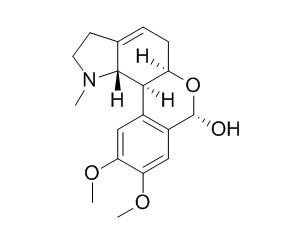Lycorenine
Lycorenine may produce a decrease in blood pressure as the result of alpha-adrenergic blockade in conjunction with the reduction of the spontaneous sympathetic nerve activity, and produce bradycardia by modifying vagal activity. The development of tachyphylaxis to the vasodepressor action of lycorenine is ascribed to maintenance of its alpha-adrenergic blocking action.
Inquire / Order:
manager@chemfaces.com
Technical Inquiries:
service@chemfaces.com
Tel:
+86-27-84237783
Fax:
+86-27-84254680
Address:
1 Building, No. 83, CheCheng Rd., Wuhan Economic and Technological Development Zone, Wuhan, Hubei 430056, PRC
Providing storage is as stated on the product vial and the vial is kept tightly sealed, the product can be stored for up to
24 months(2-8C).
Wherever possible, you should prepare and use solutions on the same day. However, if you need to make up stock solutions in advance, we recommend that you store the solution as aliquots in tightly sealed vials at -20C. Generally, these will be useable for up to two weeks. Before use, and prior to opening the vial we recommend that you allow your product to equilibrate to room temperature for at least 1 hour.
Need more advice on solubility, usage and handling? Please email to: service@chemfaces.com
The packaging of the product may have turned upside down during transportation, resulting in the natural compounds adhering to the neck or cap of the vial. take the vial out of its packaging and gently shake to let the compounds fall to the bottom of the vial. for liquid products, centrifuge at 200-500 RPM to gather the liquid at the bottom of the vial. try to avoid loss or contamination during handling.
Biochemistry.2018, 57(40):5886-5896
Pharmaceuticals (Basel).2024, 17(8):1001.
Nutrients.2024, 16(7):965.
Molecules.2021, 26(23):7390.
FEBS J.2022, 10.1111:febs.16676.
Molecules.2024, 29(5):1050.
Drug Des Devel Ther.2020, 14:61-71
Antioxidants (Basel).2024, 13(3):340.
Molecules.2023, 28(5):2376.
J Agric Food Chem.2022, 70(51):16176-16187.
Related and Featured Products
Jpn J Pharmacol. 1979 Aug;29(4):605-22.
Pharmacological studies of lycorenine, an alkaloid of Lycoris radiata Herb.: Vasodepressor mechanism in rats.[Pubmed:
537276]
Vasodepressor mechanism of Lycorenine (an alkaloid of Lycoris radiata Herb.) was investigated in anesthetized rats.
METHODS AND RESULTS:
Lycorenine (1--10 mg/kg i.v.) produced dose-related decreases in blood pressure and heart rate and tachyphylaxis developed with repeated injections. In the blood-perfused rat hindquarters, Lycorenine (62.5--500 micrograms i.a.) produced dose-related decreases both in mean blood pressure and in perfusion pressure, and the Lycorenine-induced decrease in perfusion pressure was abolished by phenoxybenzamine or hexamethonium. Lycorenine (more than 1 mg/kg i.v.) blocked the pressor response to sympathetic nerve stimulation, but failed to block the tachycardia induced by sympathetic nerve stimulation. Lycorenine (7.5 or 15 mg/kg i.v.) reduced the spontaneous splanchnic nerve activity. Lycorenine when given intracerebroventricularly produced decreases in blood pressure and heart rate only in large doses (over 500 micrograms). The maximal bradycardia induced by Lycorenine was abolished by bilateral vagotomy.
CONCLUSIONS:
It is suggested that Lycorenine may produce a decrease in blood pressure as the result of alpha-adrenergic blockade in conjunction with the reduction of the spontaneous sympathetic nerve activity, and produce bradycardia by modifying vagal activity.
Jpn J Pharmacol. 1980 Oct;30(5):655-64.
Pharmacological studies of lycorenine, an alkaloid of Lycoris radiata Herb.: II. Effects of blood pressure in rats and dogs and the mechanism of tachyphylaxis to the vasodepressor action of lycorenine in rats.[Pubmed:
6110797]
METHODS AND RESULTS:
Blood pressure responses to Lycorenine were investigated in rats and dogs. Lycorenine (10--40 mg/kg p.o.) produced a decrease in blood pressure in conscious rats which was greater in hypertensive rats than in normotensive rats. In conscious dogs, Lycorenine (5 or 10 mg/kg i.v.) produced rises in blood pressure and heart rate except for a few instances, while it produced a decrease in blood pressure in pentobarbital anesthetized dogs. Thus, there are species differences in cardiovascular effects of Lycorenine between conscious rats and dogs. The development of tachyphylaxis to the vasodepressor actions of Lycorenine and its related compounds was related to their alpha-adrenergic blocking activities at the time of the second injection in anesthetized rats. Desipramine which abolished or diminished the development of tachyphylaxis to the vasodepressor action of Lycorenine (5 or 7.5 mg/kg i.v.), shortened the duration of its vasodepressor action and reduced its alpha-adrenergic blocking action.
CONCLUSIONS:
These results indicate that the development of tachyphylaxis to the vasodepressor action of Lycorenine is ascribed to maintenance of its alpha-adrenergic blocking action.
Eur J Med Chem. 2013 May;63:722-30.
Preparation and antimalarial activity of semisynthetic lycorenine derivatives.[Pubmed:
23567962]
METHODS AND RESULTS:
A set of twenty one Lycorenine derivatives has been prepared from the alkaloid hippeastrine (1). The modifications performed on hippeastrine included some functional group transformations, structural simplification and preparation of dimers.
CONCLUSIONS:
All alkaloids were tested as potential antimalarial agents, being the hippeastrine dimers the most active compounds.
J Am Chem Soc. 2010 Apr 14;132(14):5176-8.
Total synthesis of the lycorenine-type amaryllidaceae alkaloid (+/-)-clivonine via a biomimetic ring-switch from a lycorine-type progenitor.[Pubmed:
20235577]
METHODS AND RESULTS:
A fully diastereoselective total synthesis of the Lycorenine-type Amaryllidaceae alkaloid (+/-)-clivonine (19) is reported via a route that employs for the first time a biomimetic ring-switch from a lycorine-type progenitor, thereby corroborating experimentally the biogenetic hypothesis first expounded for these compounds by Barton in 1960.



